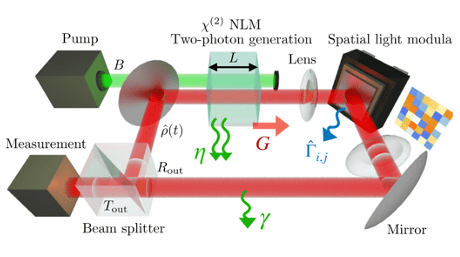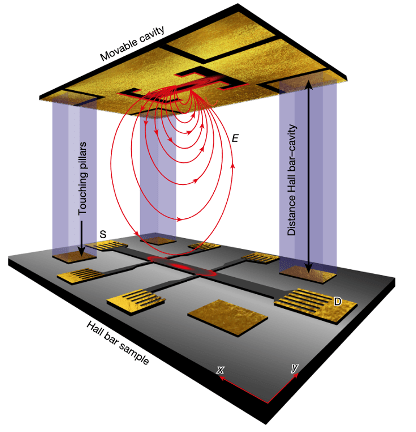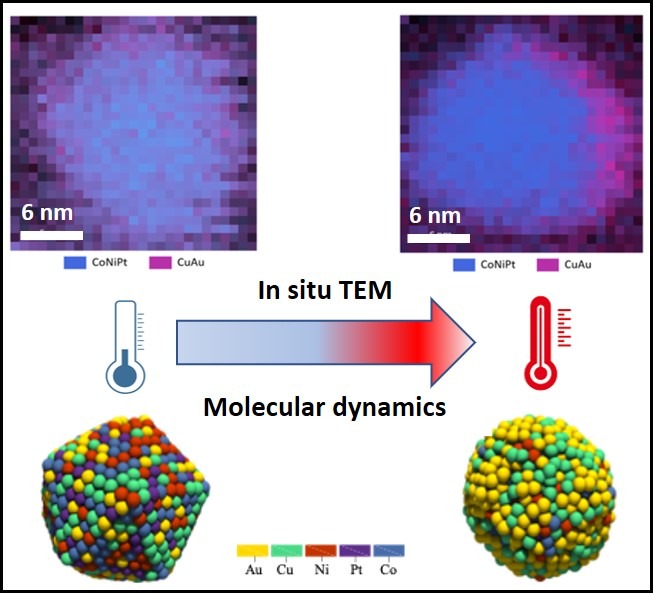Research topics
Our group uses optical and THz spectroscopic techniques to study correlated and topological electronic phases of matter. Our main research axis are currently superconductictivity, magnetism and multiferroicity, 2D materials and topological semi-metals. In general our reseach focus on quantum materials, materials where many-body quantum interactions and effects play a major role in establishing their properties.
Unconventionnal superconductivity: cuprates and iron-based superconductors
High-Tc cuprates
Superconducting (SC) copper oxides (cuprates) were discovered over 37 years and yet they continue to fascinate condensed matter physicists. There are two main reasons for this. The first is that cuprates, are superconductors at high temperatures. The second is that cuprates have remarkable physical properties that can be modulated by varying the doping in carriers.

Temperature versus doping phase diagram of the cuprayte Hg1201 showing pseudogap (PG), charge density wave (CDW) and supercoduncting phases as extracted from various experimental techniques.
By increasing the doping, a cuprate goes from an insulating antiferromagnetic (AFM) phase to a metallic phase; then by lowering its temperature it becomes superconducting. This double transformation from (insulator to metal) and (metal to superconductor) is one of the most spectacular and mysterious phenomena that condensed matter physicists have to elucidate. This transition is manifested by the appearance of several coexisting electronic orders that break several symmetries: invariance by translation (charge order), invariance by time reversal (local magnetic order) or invariance by rotation (nematic order). All of these electronic orders are hosted by an emblematic phase that remains mysterious and is called the pseudogap phase. One of our flagship results in recent years has been to reveal the existence of a microscopic link between the superconducting (SC) order and the charge (CDW) order. Indeed, the characteristic energy scales of these two orders are superimposed in a certain range of doping. Moreover, they follow the same doping behaviour as the pseudogap energy (PG). This strongly suggests, that the charge order, the superconducting order and the pseudogap phase have a common origin[1]. Our recent works and their trajectory consist in unveiling this common origin, which are likely to be short-range antiferromagnetic interactions[2].
[1] B. Loret et al. Nat. Phys. 15, 771(2019)
[2] M. Mezidi et al. Phys. Rev. B 106, 174513 (2022)
Nematicity and superconducting in iron-based superconductors

Top: Coupling between uni-axial strain and nematic degrees of freedom (here a deformation of the Fermi surface). Bottom: a scaling is found between the change in nematic susceptibility and superconducting Tc in Ba(Fe1-xCoxAs)2 under strain
Discovered in 2008, the iron-based superconductors (Fe SC) have become the second family of high-temperature superconductors besides cuprates with Tc reaching 55K in the bulk material NdFeAsO and possibly above 70-80K in monolayer FeSe. Contrary to cuprates they are not doped Mott insulators, but metals with moderatetly strong correlations and a marked multi-orbital character. Of particular interest in these materials in the proximity of the superconducting phase to an electronic nematic phase where the electron fluids break the 4-fold symmetry of the underlying lattice. This unusual phase of matter, essentially an electron analogh of the well-studied classical counterpart in liquid crystal physics, is now thought to be pervavive in many correlated multiband metals but had remained elusive up to recently because of a lack of appropriate experimental probes. A key question in the field of Fe SC is whether critical nematic fluctuations can act as a pairing glue and promote superconductivity in Fe SC just like lattie vibration in conventional SC and magnetic fluctuations in cuprates. The SQUAP team has pionnered the use of polarized Raman scattering to access the nematic degrees of freedom and study their interplay with superconductivity in Fe SC. In the iron-chalcogenide FeSe, probing the evolution of the nematic fluctuations spectrum under both hydrostatic (up to 7 GPa) and chemical pressure (substituting Se with S), we have demonstrated that they play a marginal role in promoting SC[1]. In iron-pnictide like BaFe2As2 however, we have shown using a new Raman scattering set-up under tunable anisotropic strain that nematic fluctuations significantly enhance superconductivity. Here we have leveraged the direct coupling between anistropic strain and the nematic degrees of freedom and revealed a remarkable scaling between the superconducting transition temperature Tc and the static nematic susceptibility[2]. We are currenly pursuing this research axis by exploiting anisotropic strain as a continuous symmetry-resolved tuning parameter to selectively modify the superconducting ground state of Fe SC.
[1] P. Massat et al. Phys. Rev. Lett. 121, 07701 (2018), S. Chibani et al. npj Quant. Mat. 6, 37 (2021)
[2] J. C. Phillippe et al. Phys. Rev. Lett. 129, 187002 (2022)
The superconducting Higgs mode
Ferroic materials
This topic is centered on oxide compounds and in particular on multiferroics in which coexist magnetic and ferroelectric phases with cross-correlation effects between magnetic and electrical degrees of freedom. The main objective of this topic is to probe the ferroelectric and magnetic states and the dynamic coupling between spin and charge degrees of freedom in several classes of oxydes. The main compound studied here is BiFeO3 (BFO), the most studied multiferroic for its ferroelectricity and magnetic properties at room temperature. BFO has been investigated under hydrostatic pressure (bulk), under 2D epitaxial strain (thin films) and under uniaxial strain (in progress). Our work on BFO thin films with the UMR Thales has shown how spin order and spin excitations can be modulated and controlled by epitaxial strain and magnetic field[1]. We have also worked on BFO nanoparticles[2] in which we have shown the effect of surface expansion with size reduction on phonons and magnons and pointed out the signature of the interaction between an additional ferromagnetic moment and the surface. We have tracked electromagnons, spins possessing an electric dipole, in the CuO compound[3]. Using the THz spectroscopy at the AILES beamline of synchrotron SOLEIL and high pressure, we demonstrate that in CuO, a relatively modest hydrostatic pressure (3GPa) allows an increase of the electromagnon strength by a factor 7 and an extension of its temperature range of existence by more than 40 K. We also propose a roadmap to achieve these properties in CuO thin films. Since the discovery of a two-dimensional electron gas (2DEG) at the interface between two band insulating oxide, SrTiO3 (STO), a wealth of intriguing properties has emerged in this seemingly simple oxide system. STO exhibits superconductivity, incipient magnetism, thermoelectricity and electronic correlations, properties that can be tuned by controlling oxygen vacancies, electrostatic gate potentials and strain. A unique combination of infrared ellipsometry and confocal Raman spectroscopy reveals the important role played by the electromigration of oxygen vacancies and their clustering at the antiferrodistortive domain boundaries of SrTiO3, which generates local electric and possibly also flexoelectric fields and subsequent polar moments with a large lateral component.[4]
In the near future, we plan to study dynamical coupling between spin and lattice degrees in the R2L2O7 pyrochlores with original quantum spin liquid state using the established spectroscopic techniques Raman and THz as well as the novel time-resolved versions of theses spectroscopies. We want also to investigate the electronic properties of STO and doped STO under uniaxial strain using Raman spectroscopy and IR spectroscopy at SOLEIL. A second stage is devoted to the implementation of time-resolved Raman spectroscopy on STO to achieve a ferroelectric metastable state and to study the behavior of the structural and spin excitations back to equilibrium. For multiferroic materials like BiFeO3 and TbMnO3 we are planning to drive the phonons and/or the electromagnons with THz electric field in order to manipulate the magnetic order.
[1] A. Agbelele et al. Adv. Mat. (2017), D. Sando et al. Phys. Rev. Mat. (2019), D. Sando et al. Appl. Phys. Rev. (2019)
[2] I. Aupiais et al. Phys. Rev. Mat. (2019), I. Aupiais et al. Appl. Phys. Lett. (2020), S. Beairsto et al. Phys. Rev. B (2021)
[3] M. Verseils et al. NPJ Quant. Mat. (2023)
[4] F. Lyzwa et al. NPJ Com. Phys. (2022)
Ultrafast Light control of quantum materials

(a) Two colour pump probe schema for polarization and time resolved Raman scaterring. (b) Transient phonon spectrum as a function of pump-probe delay in Ta2NiSe5. (c) Polarization resolved phonon intensity ratio used as a marker of the structural symmetry as a function pump-probe delay. The finite intensity ratio at all delays indicates a preserved lattice symmetry
The use of ultrafast light to probe and modify materials properties is an emerging field with potentiallyfar-reaching implications, including light control for on-demand properties. To achieve so, one needs to develop intense light sources in the spectral range of relevant excitations in solids, usually in the THz or Mid-IR, in order to selectively address specific electronic, lattice or magnetic degrees of freedom. Starting in 2020 the team has initiated a new research axis with the developpement of two complementary ultrafast spectroscopy set-ups based on time domain THz spectroscopy and time-resolved Raman scattering. The first version of the time-resolved Raman set-up was finalized early 2022 and results have been obtained on the exictonic insultator candidate Ta2NiSe5. In this compound the lattice or electronic origin of the semi-metal to insulator transition observed below Tc=325K is still under debate. Via the use of time and polarization-resolved Raman below Tc, we have shown that after a near-IR ultrafast pump pulse, a transient metallic-like metastable phase with the lattice symmetry of the insulating phase is established[1]. This unambiguously shows that the lattice plays a marginal role in establishing of the insulating phase and clearly favors an electronic instability, which is consistent with the excitonic scenario.

(a) Schema of the verstaile THz spectroscopy set-up, combining optical or THz pump with the THz spectroscopy probe, both in transmission and reflection geometries. (b) Schema of the different photoexcitation channels in Dirac or Weyl semimetals, with linear band dispersion, using optical or THz pump energies.
The time-resolved THz spectroscopy set-up is currently under development. It aims at offering several configurations to investigate ultrafast dynamics in quantum materials. In particular, the current projects focus on investigating carrier and structural dynamics in Dirac and Weyl semimetals. These recently-discovered materials present intriguing topological properties, which are difficult to access experimentally. They consequently present exceptional electronic and magnetic properties, including in particular a 3D cone-shape linear band structure, around a Dirac point. The first scope aims at exploring the carrier dynamics and the exact band structure specifically in the low energy range, close to the Dirac point, while only the high energy range has been explored. The second scope focuses on exploring light-induced structural modifications, identifying the responsible mechanisms. Since topological properties are dependent on the lattice symmetry, inducing structural distortions, i.e. driving atoms out of equilibrium, could expectedly lead to changes in the topology. To achieve these goals, the THz setup needs to be versatile and combine both optical and intense THz pump with broadband THz spectroscopy which can probe both carrier and IR-active phonons. Future developments will associate THz pump with time-resolved Raman spectroscopy, enabling to pump specifically at low energy (Higgs mode, phonons, low energy carrier), while probing electronic responses (superconductor gap) and Raman-active phonons.
[1] K. Katsumi et al. Phys. Rev. Lett. (2023)
À lire aussi

Emergent Equilibrium in All-Optical Single Quantum-Trajectory Ising Machines
A collaboration between the Theory group at MPQ, CREF Rome, and Sapienza University of Rome has shown that multimode all-optical systems driven by two-photon processes can reach thermal equilibrium at the level of single quantum trajectories. The study is published in...

Cavity-enhanced fractional quantum Hall phases and cavity-modified spin splittings
A collaboration between the Equipe Théorie at MPQ and scientists from ETH Zurich and the Flatiron Institute has demonstrated, both theoretically and experimentally, that giant vacuum fields confined in a split-ring resonator cavity can profoundly alter...

Unravelling the nonlinear generation of designer vortices with dielectric metasurfaces
Researchers from the DON team have demonstrated and analyzed the generation of high-purity second-harmonic vortices with dielectric metasurfaces. These results are published in Light: Science and Applications. Vortex beams are currently drawing a great deal of...

Thermal stability of high-entropy nanoalloys: reality or chimera?
By studying at the atomic scale the thermal behavior of nanoparticles composed of gold, cobalt, copper, nickel and platinum, scientists have revealed that the stability of these so-called high-entropy nanoalloys is much lower than expected, as gold and copper...
